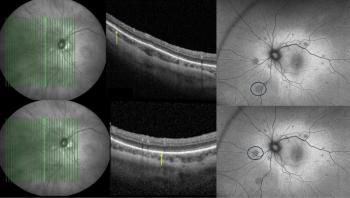
Reducing treatment burden, cost and re-treatment
For neovascular AMD sufferers, this combination therapy may offer an alternative to continual anti-VEGF injections
Monthly re-treatments with anti-VEGF drugs are, to some extent, costly and time-consuming to doctors, patients and the healthcare system. In my region of the UK, we have 500 patients on active Lucentis treatment, with only 350,000 total residents. Early estimates on the prevalence of this disease presumed a maximum of 750 per million residents. These analyses were done prior to the advent of effective treatments for AMD, and are likely to have been grossly underestimated if my region is any indication.
The ongoing treatment burden, possibility of tachyphylaxis (although I have not personally found that to be the case in my patient population) and cost of monthly injections has led to the exploration of alternate modalities.
The device is currently being utilized in hospitals in the UK as part of the Macular EpiRetinal Brachytherapy Versus Lucentis Only Trial (MERLOT). The MERLOT Trial is a multi-centre, randomized, controlled, clinical study of the VIDION System. It has been awarded portfolio status by the NIHR-CCRN as part of the 'Best Research for Best Health' initiative. Its objective is to test the hypothesis that epimacular brachytherapy will reduce the frequency of injections needed by patients to control their disease. A total of 363 patients will be enrolled.
Interim results from the MERITAGE I (Macular Epiretinal Brachytherapy in Treated Age-Related Macular Degeneration Patients) trial have found that radiation and anti-VEGF injections can potentially reduce the treatment burden and maintain the visual acuity (VA) in patients with neovascular AMD. One of the key end points of interest with epimacular brachytherapy, is its potential to reduce the number of anti-VEGF injections needed. MERITAGE only enrolled patients in whom ongoing injections were necessary for visual gain maintenance.
The procedure
I find the procedure with VIDION ANV therapy system to be very straightforward and well within the core skill set of vitreoretinal surgeons. Surgeons can use any preferred vitrectomy technique with which they are comfortable. The probe used to deliver the treatment is 20-gauge, so one sclerostomy port needs to be enlarged if a 23- or 25-gauge system is used. Patients undergoing the procedure usually require only local anesthesia and the entire procedure normally takes less than one hour.
Although the procedure is straightforward and can be easily adopted by a vitreoretinal surgeon, it nevertheless is an interventional surgery and any of the complications associated with a standard vitrectomy may occur. In the patients I have performed the procedure on to date, I have had no concerns.
Newsletter
Get the essential updates shaping the future of pharma manufacturing and compliance—subscribe today to Pharmaceutical Technology and never miss a breakthrough.













































